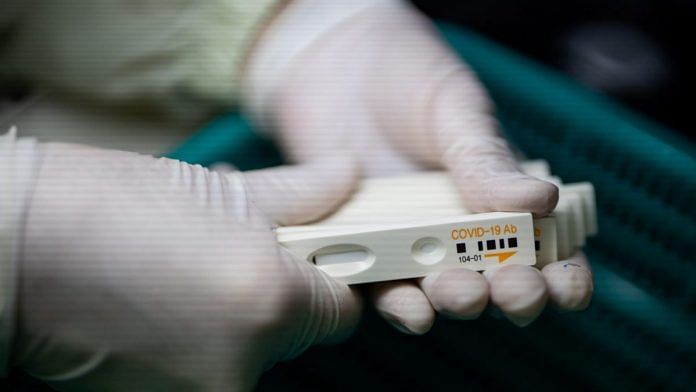New Delhi: Sixty districts and 10 cities. Twenty-one states. Over 24,000 subjects. The Indian Council of Medical Research (ICMR) is conducting a large-scale exercise to assess Covid-19 exposure across the country.
Armed with serological tests — blood tests that look for antibodies to diagnose exposure to a microorganism, in this case, the novel coronavirus — teams across India are trying to gauge the incidence of Covid-19.
Based on random sampling, the tests are also expected to factor in asymptomatic patients who may not have accessed formal healthcare facilities for treatment.
The project was announced earlier this month, but the ICMR, India’s apex agency for medical research, released the protocol guiding the exercise Sunday.
ThePrint went through the protocol to explain just how the mega surveillance exercise is being carried out.
Also Read: HCQ breakthrough: ICMR finds it’s effective in preventing coronavirus, expands its use
‘Minimising biases’
The protocol for the ICMR’s community-based sero-surveillance was published in the Indian Journal of Medical Research (IJMR) Sunday. Titled ‘National sero-surveillance to monitor the trend of SARS-CoV-2 infection transmission in India: Protocol for community-based surveillance’, the protocol was penned by researchers of the ICMR, the World Health Organization (WHO), the All India Institute of Medical Sciences (AIIMS), the Indian Institute of Public Health (IIPH), the Public Health Foundation of India (PHFI), the National Centre for Disease Control (NCDC), the Jan Swasthya Sahyog, and two independent consultants.
“Through household-targeted, antibody-based serologic testing, we can minimise the biases of referral and selective testing affecting laboratory-based surveillance, generate evidence on the role of asymptomatic infection in driving transmission and estimate the extent of infection in a given population,” the protocol states.
The surveillance will focus on detecting immunoglobulin G (IgG) antibodies, which are found in an individual’s blood circulation in the recovery phase of the infection. This will be done through indigenous Enzyme-Linked Immunosorbent Assay (ELISA) testing kits.
Sample collection
The WHO has suggested three lines of “seroepidemiological investigation”, which means an investigation involving the identification of specific antibodies in individuals. They are: A cross-sectional investigation, a repeated cross-sectional investigation in the same geographic area, and a ‘longitudinal cohort study’ with serial sampling of the same individuals.
The ICMR went with the second option — a repeated cross-sectional study, where different individuals are asked the same information. This line of investigation, the ICMR said in the protocol document, is the most appropriate for India as the country is “in the early stages of the pandemic”.
When the ICMR first announced the exercise 12 May, it listed 69 districts as the study areas. The protocol, however, states the surveillance is taking place in 60 districts along with the top 10 cities “reporting the highest number of cases”. The districts have been classified according to their Covid-19 case load — zero, low, medium or high.
Each district has been divided into 10 “clusters”, which are villages in rural areas and wards in urban areas.
In each cluster, the survey team chooses four random locations. From each of these locations, 10 households are chosen, and one adult from each household is then engaged for the study. This means, 400 people have participated in the study from each district.
Also Read: Muzzling the ICMR — Why we know so little about Covid-infection levels in India
‘Testing of samples will take time’
The prevalence of the SARS-CoV2 infection “will be estimated in different rounds of serosurveys”, the protocol states. “The trend of seropositivity (those with IgG antibodies) will also be looked at to monitor the community-level transmission,” it further says. Finally, the cumulative data from the districts will be used to estimate the overall prevalence of Covid-19 infection.
“We will be completing the sample collection by the end of this week,” Dr Manoj Murhekar, the director of ICMR’s National Institute of Epidemiology told ThePrint Friday, when approached with queries on the estimated timeline of the study.
“After that the testing will start, then we’ll see. The testing of 24,000 samples will take some time… It takes about 3 to 3.5 hours to do one test. So it will take at least a week or 10 days.”
Also Read: Hope over fear, joy after despair — our 14 days in quarantine were a lesson in positivity






